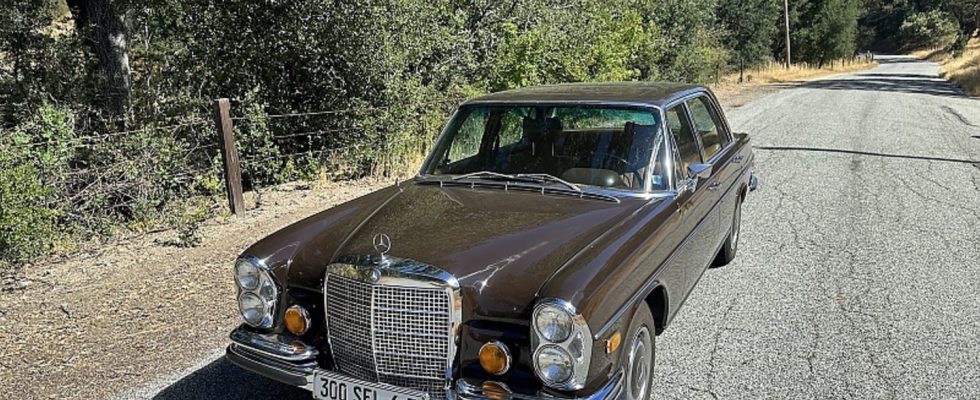Classic: Mercedes 300 SEL 6.3
The sports car hunter
Mercedes 300 SEL 6.3 from the W 109 series
© press-inform – the press office
The late 1960s were an extremely exciting time, and not just politically. The global car scene in particular was more creative than ever before. Strongly influenced by American luxury trends, Mercedes offered an S-Class with its luxury sedan from the W 109 series that was not yet called that.
The equally elite top model of the Mercedes 300 SEL 6.3 shares the extremely powerful drive with the Mercedes 600. The 6.3 liter eight-cylinder model M100 delivers 184 kW / 250 hp and a gigantic 500 Nm maximum torque at 2,800 rpm. The eight-cylinder offers, among other things, an eight-piston injection pump with automatic start and warm-up that takes into account the accelerator pedal position, engine speed, air pressure and cooling water temperature. The fuel is injected into the intake manifolds at maximum pressure via eight nozzles – this brings the then opulent power to the rear axle. In order to accommodate the engine in the W 109 series, the front frame, transmission tunnel and car floor were modified. The top version of the 6.3 goes back to an idea by the test engineer Erich Waxenberger. He recognized the potential of the V8 engine from the 600 model for the W 109 series. Initially, without the knowledge of development boss Rudolf Uhlenhaut, he built a test vehicle. But what he’s doing doesn’t remain hidden from him for long: He hears the prototype driving past his office with a subtle engine rumble, immediately orders Waxenberger to report – and allows it to be used for further development.
The brown 6.3 Series still impressively shows how sporty a German luxury sedan could be at the end of the 1960s. Paired with the automatic transmission, also borrowed from the 600, it takes a second to think after hitting the accelerator pedal, the delicate colossus bends slightly and then pushes forward, babbling shamelessly and sonorously. From a standstill it takes 6.5 seconds to reach the 100 mark and the delicately designed luxury sedan manages the standing start in just under 28 seconds. If you want to, you can push it up to over 220 km/h. When it was presented to the public in the spring of 1968, it was not only a real show at the Geneva Salon. Not only because its luxury equipment set new standards, but not least because the 300 SEL 6.3 hardly differed visually from its weaker brothers. The US version can be recognized not only by the side marker lights, but especially by the yellow additional headlights, which only at first glance look like yellow fog lights, but are responsible for changing the direction of travel.
On the road, the difference in comfort compared to the W-108 versions with steel suspension is quite impressive, as the rear of the Swabian luxury sedan in particular bounces impressively over almost everything that stands in its way. The driver can adjust the level of the star limousine using a switch on the left above the knee. The combination of the 6.3-liter eight-cylinder injection engine and the four-speed automatic transmission is surprisingly rough when changing gears, because in contrast to the other US versions with three gearshifts, the top model’s transmission does not have a torque converter that dampens the gearshifts. This was only incorporated into the successor generation of the W 116 and brought a noticeable increase in comfort for the driver and passengers. This ensures that the eight-cylinder engine bites more robustly and powerfully than you would expect. Driving fun is guaranteed, even if the soft tuning of the springs and dampers makes the “rolling home” sound louder than desired without having to use the pit system.
The interior offers plenty of space and even more comfort. Both were not quite at the level of the American competition at the time, but in addition to central locking and electric windows, the Sindelfinger also offered adjustable air springs, air conditioning and an electric sliding roof that brought plenty of air and light into the interior; plus a radio and electric antenna. What was unusual, however, was that the W 109 did not offer exterior mirrors that could be adjusted from the inside and the rear headrests were an absolute rarity in the US versions, which only became increasingly common with the successor generation of the W 116. Otherwise, the equipment differed only slightly from the 300 SEL 2.8 and its much more powerful successor, the 300 SEL 3.5, which with its 147 kW / 200 hp eight-cylinder engine not least introduced electronically controlled fuel injection at Mercedes. From 1971 onwards there was a similarly powerful 4.5 version for the USA with 146 kW / 198 HP, which could also be fueled with a lower octane number. The Mercedes 300 SEL 6.3 model, which initially cost just under 40,000 German marks, was in demand due to its performance at the sports car level of the time, but was rather a rarity. Of the more than 380,000 S-Class predecessors of the W 108 / 109 generations produced, barely more than 6,500 models were equipped with the large eight-cylinder. The bestseller was the basic version of the 280 S with over 90,000 sales.

